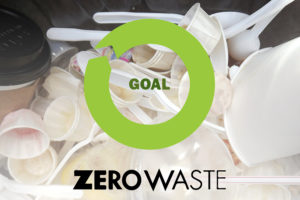Pop Culture dictionary
zero-waste travel
[zeer-oh weyst trav-uh l]
What does zero-waste travel mean?
Zero-waste travel is the act of traveling in a way that greatly reduces one’s environmental impact, specifically by limiting the amount of trash generated. Practices include bringing reusable toiletries containers, portable composting, and consciously minimizing one’s carbon emissions.
Where does zero-waste travel come from?

Zero-waste travel is part of the zero-waste movement. This environmental movement picked up steam in the early 2000s to promote responsible production (eliminating packaging and toxins), sustainable consumption (use all you can), and reuse (whatever you can’t consume).
Zero-waste refers to the elimination of forms of harmful refuse, especially packaging that ends up in landfills and incinerators. Ultimately, a zero-waste lifestyle generates no trash–nothing that can’t be repurposed in some way. Recycling and composting are pillars of a zero-waste strategy. Reducing single-use plastics has also been a major focus in the late 2010s.
It wasn’t long before the zero-waste movement turned its eye towards travel. In general, traveling can be incredibly waste-intensive, from single-use travel toiletries, to plastic packaging, to the carbon emissions from planes and cars.
The phrase zero-waste travel is evidenced by at least 2012, when Amy Korst included a chapter on it in her book The Zero-Waste Lifestyle. The term, and concept, spread in 2015 with bloggers and vloggers documenting their own adventures in–and providing guides to–zero-waste travel.
In addition to zero-waste travel, other efforts in the zero-waste movement include zero-waste cities, zero-waste homes, and zero-waste stores.
Examples of zero-waste travel

Who uses zero-waste travel?
Online, people may use the hashtag #zerowastetravel or #zerowastetraveller to share about, encourage, and educate people on zero-waste adventures.
Zero waste travel buddy duel 2.0!!! After some great times earlier in the year in Kuala Lumpur, the duel strikes back with zero waste fight!!! :) ♻️
♻️
♻️
♻️
♻️#ecofriendly #recycle #sustainability #zerowaste #ecodesign #recycling #reuse #foodwaste #upcycle #zerowastelifest… pic.twitter.com/hEGWJxKOSD— NoFootprintNomads.com (@NFNcom) November 12, 2018
Travel companies, websites, and influencers may also write about zero-waste travel to promote their products and brands—and, above all, a greener lifestyle.
Zero waste travel: Packing using less packaging https://t.co/kRjvQchTKF on @bloglovin
— AWanderlustForLife (@AWlustForLife) January 17, 2019
In late 2018, the company Natural Habitat Adventures announced that it will be creating the world’s first zero-waste trip to Yellowstone where all guests will be given a zero-waste toolkit with reusable items. Their aim is for all waste generated from the trip to fit into a single small container. Not quite zero waste, but close.
Top Diy story: Natural Habitat Adventures launches zero-waste vacations | Inhabitat – Green Design, Innovation, Architecture, Green Building https://t.co/UhtMuQLNm5, see more https://t.co/va9CZrcnbD
— Mr. DIY (@diy_website) September 17, 2018
Note
This is not meant to be a formal definition of zero-waste travel like most terms we define on Dictionary.com, but is rather an informal word summary that hopefully touches upon the key aspects of the meaning and usage of zero-waste travel that will help our users expand their word mastery.